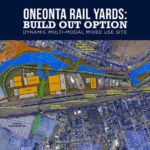The Daily Star | Denise Richardson
January 16, 2018
ONEONTA — The Common Council declared itself lead agency Tuesday night in the environmental review of the Oneonta Rail Yard project and said development potentially will have some adverse impacts on the site and nearby area.
The re view and actions were the first formal steps in preparing and working toward redevelopment of the rail yards off of Chestnut Street and North Fonda Avenue.
view and actions were the first formal steps in preparing and working toward redevelopment of the rail yards off of Chestnut Street and North Fonda Avenue.
“This is a significant first step,” Mayor Gary Herzig said after the motions were approved. The project is one of the largest job-creation initiatives the city has seen in decades, he said.
The Oneonta Rail Yard project was presented last year when a newly created local development corporation announced in April the purchase of about 80 acres in the city for economic development purposes. The property, on either side of Roundhouse Road, was purchased from Oneonta River Corp. for $250,000 and the Otsego County Industrial Development Agency provided funds.
Delaware Engineering, on behalf of the IDA, submitted an application for site plan review and a mandated State Environmental Quality Review Act full Environmental Assessment Form to the city.
In September, the Council approved its intent to be lead agency in the SEQRA process and didn’t receive any objections from other involved agencies.
On Tuesday night, Council members reviewed application materials and environmental factors, determined that an Environmental Impact Statement must be made and authorized the mayor to sign necessary documents.
The IDA, which is part of the economic development group Otsego Now, will prepare a redevelopment master plan and economic development strategy for about 50 acres of the 80-acre site.
Redevelopment of the Oneonta Rail Yard site, centered on Roundhouse Road, will involve the construction of structures, parking, and access to the site which may include a bridge as a well as the extension of utility infrastructure and site roadways, according to the project description in the motion approved by the Council. The project has a total potential area consisting of about 17 individual parcels and approximately 200 acres with access to public water and sewer systems as well as natural gas.
The project would provide an opportunity to create a new industrial/commercial business park that would provide additional markets for Otsego County, create jobs and add to the local tax base, the motion said.
The Council adopted also a “positive declaration” for the project, which means some potentially adverse impacts may occur. The next phase, or scoping, will be like a “table of contents” of impacts, officials said, and a draft scoping document will be prepared for Council review.
Scoping of the Draft Generic Environmental Impact Statement will include opportunity for public involvement, according to the motion, and officials said a draft may be ready in a few weeks.
Elizabeth Horvath of Delaware Engineering told Council members that “this is the very beginning” of the process as she reviewed some factors in the proposal.
“We intend to go very, very deep into the environmental review process,” she said. The IDA will bear the costs, she said.
According to documents reviewed by Council members Tuesday night and specifics included in their approved motion, the project and its potential impacts are significant in magnitude and the number of persons affected.
Also, the motion said:
• Potential adverse impacts were found to exist with respect to transportation, energy demand, wetland loss/impairment, and storm water.
• Traffic generated by the project could decrease safety on local roadways and increase congestion, and will require improvements to the local road network.
• The project may require high energy demands that may necessitate upgraded utility infrastructure, officials said.
• The project may involve construction within or adjoining a freshwater wetland and result in a decrease of more than 10 percent of the on-site wetlands. Officials said about 2 acres might be impacted.
• The project is proposed to involve the construction of significant impervious surfaces, which will result in an increase in storm water runoff.
